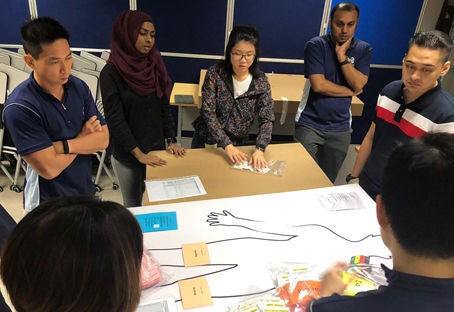HealthXchange will NEVER ask you to transfer money over a call. If in doubt, call the 24/7 ScamShield helpline at 1799, or visit the ScamShield website at www.scamshield.gov.sg.

Terror attacks. Mass casualties. During civil emergencies like these, the Ministry of Health's Disaster Site Medical Command (DSMC) coordinates the medical response, mobilising civilian doctors and nurses to provide support at the disaster site. This year, MOH has partnered with SIMS to successfully conduct the Disaster Medical Responders Course (DMRC) that equips first responders and field team members across the nation in basic disaster medical response.
"Even though we may be familiar with medical treatment in our daily work, civil emergencies come with added psychological or emotional dimensions. These can affect the quality and rate of our response to the situation." Dr Keith Ho, Deputy Commander of the DSMC, shared. "We therefore see the DMRC course as a critical platform to train the way our medical team members respond under intense conditions."
Close to 30 doctors and nurses across Singapore's healthcare clusters attended the DMRC course run in June 2019, where they gained an overview of disaster response and operations. One of the training highlights was a table-top exercise for medical teams to practice their response. Life-sized cardboard mock casualties were printed, with corresponding details like medical information and demographics. Teams had to prioritise treatment for multiple casualties with the limited resources (equipment, manpower, time, ambulances) available.
"Introducing a time aspect teaches our responders the value and impact of their medical decisions in tight situations." Dr Mathew Yeo, Assistant Commander of the DSMC, explained. "The exercises at DMRC seek to get participants as close as possible to a real-life disaster, so that when real emergencies strike, our healthcare professionals can anticipate and respond readily."

Teams at the DMRC course taking part in the table-top exercise
For participant Dr Liu Zhenghong, SingHealth Emergency Medicine Resident, the table-top exercise was an effective one. "It allowed me to see how medical response would play out in a real-life scenario. I was able to understand the potential difficulties the team would face and how these could be avoided in the future."
Dr Liu also shared how the course had given him insight into the overarching framework on disaster medical response. "In a real-life civil emergency, I may not have worked with any of the people on the ground, like the forward medical team or SCDF personnel. By understanding our roles in the bigger scheme of things, it helps us all to speak the same language, resulting in a more coordinated response to the crisis at hand."
+++
Read the latest simulation stories here to learn how SIMS has helped healthcare professionals hone their clinical and surgical competencies through simulation for better patient care!
Get the Health Buddy App
© 2025 SingHealth Group. All Rights Reserved.













 Get it on Google Play
Get it on Google Play